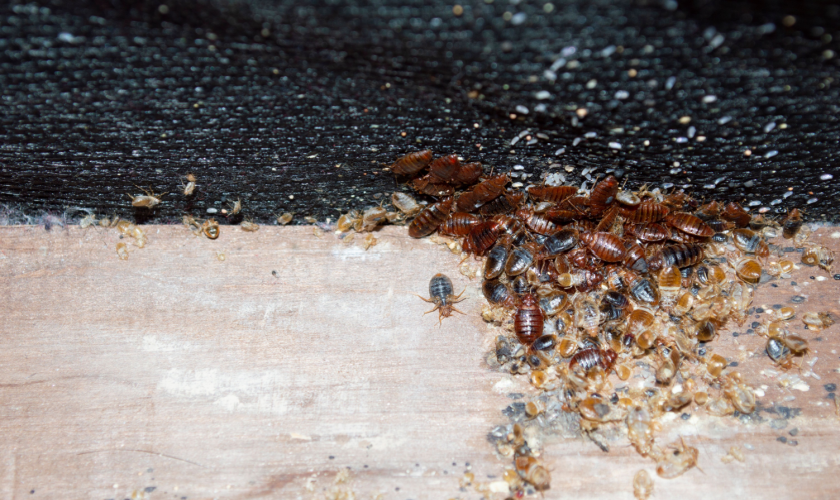A1 Bed Bug Exterminator Houston: Quick Removal Solutions
A1 Bed Bug Exterminator Houston: Quick Removal Solutions
Blog Article
Comprehending the Lifecycle of Pests for Targeted Control Strategies
Understanding the lifecycle of parasites is an essential facet of reliable pest administration methods. By comprehending the numerous phases of growth that bugs undergo, a more accurate and targeted approach can be taken on to regulate their populaces. This understanding not just sheds light on the vulnerabilities within the insect lifecycle yet likewise paves the means for applying critical measures that can disrupt their growth and reproduction cycles. With a much deeper understanding of just how parasites progress and prosper, tailored control strategies can be developed to resolve details points in their lifecycle, ultimately causing even more successful parasite management outcomes.
Relevance of Understanding Pest Lifecycle
Comprehending the lifecycle of bugs is vital for creating reliable and targeted control strategies in pest administration. By comprehending the numerous stages a parasite goes with from egg to adult, bug control professionals can recognize susceptible factors in the lifecycle where intervention can be most successful.
Moreover, acknowledging the details environmental conditions necessary for each and every stage of the pest's lifecycle can guide choices on habitat adjustment or exclusion techniques to lower and disrupt the lifecycle bug populaces. This knowledge makes it possible for pest management professionals to apply aggressive measures rather than relying solely on reactive therapies, resulting in even more lasting and lasting insect control solutions. Inevitably, a comprehensive understanding of bug lifecycles encourages insect control practitioners to customize their methods effectively, reducing ecological effects and maximizing control end results.
Secret Phases in Pest Development
To successfully execute targeted control methods in parasite management, a crucial element exists in comprehensively recognizing and understanding the key stages in bug advancement. Bug development typically is composed of numerous key phases that are crucial for their lifecycle and monitoring.

Susceptabilities in Parasite Lifecycle
Throughout the various stages of a bug's lifecycle, distinct vulnerabilities arise that can be purposefully targeted for efficient control actions. One important susceptability lies in the egg stage, where insects are typically extra susceptible to certain insecticides or biological control agents because of their soft external covering, making them less complicated targets for treatment. In addition, the larval or nymph phase presents susceptabilities as parasites undertake quick growth and advancement, needing high power consumption that can be exploited by interrupting their food sources or introducing development inhibitors. Pupal phases, characterized by immobility and transformation, use a window for targeted control with physical barriers or specific treatments that hinder successful emergence. Grown-up insects, while more resistant due to their reproductive capacity, can still be vulnerable throughout breeding or egg-laying activities, which can be interfered with through pheromone traps or sanitation strategies. Understanding these susceptabilities in the parasite lifecycle is vital for developing efficient and specific control techniques that effectively take care of pest populations while decreasing environmental impact.
Applying Targeted Control Actions

Executing targeted control actions commonly entails a multi-faceted method. This may consist of environment adjustment to make the environment have a peek at this website less welcoming to pests, such as eliminating standing water for mosquito control or securing entrance points for rats. In addition, organic control methods can be made use of, where natural killers or pathogens are introduced to keep insect populaces in check.
Integrated Pest Monitoring (IPM) methods that integrate different control actions in a worked with and lasting way are often the most efficient in attaining lasting bug monitoring goals. By carrying out targeted control steps based on a thorough understanding of insect lifecycles, parasite populations can be properly controlled while decreasing dangers to human health and the atmosphere.
Improved Insect Management Practices

Moreover, the consolidation of look at this now organic control representatives, such as natural killers or virus of pests, can help decrease dependence on chemical pesticides and advertise a more balanced community. Implementing physical obstacles and traps can also become part of boosted pest administration methods, supplying non-toxic and targeted options for parasite control. In addition, the use of pheromones and various other semiochemicals can interfere with pest breeding patterns and communication, causing decreased parasite populations gradually.
Final Thought
By recognizing vital phases in bug advancement and susceptabilities in their lifecycle, targeted control procedures can be applied to decrease bug populaces. Enhanced insect administration methods can help lower the reliance on broad-spectrum pesticides and promote more ecologically pleasant and sustainable insect control methods.
Recognizing the lifecycle of parasites is necessary for establishing effective and targeted control approaches in parasite administration. By comprehending the numerous phases a parasite goes through from egg to grownup, insect control experts can determine at risk points in the lifecycle where intervention can be most effective. Eventually, an extensive understanding of pest lifecycles equips parasite control professionals to customize their approaches properly, minimizing ecological influences and maximizing control end results.
By applying targeted control measures based on a comprehensive understanding of pest lifecycles, look these up bug populations can be effectively controlled while decreasing risks to human health and wellness and the atmosphere.
By identifying essential phases in insect development and vulnerabilities in their lifecycle, targeted control steps can be carried out to decrease parasite populations.
Report this page